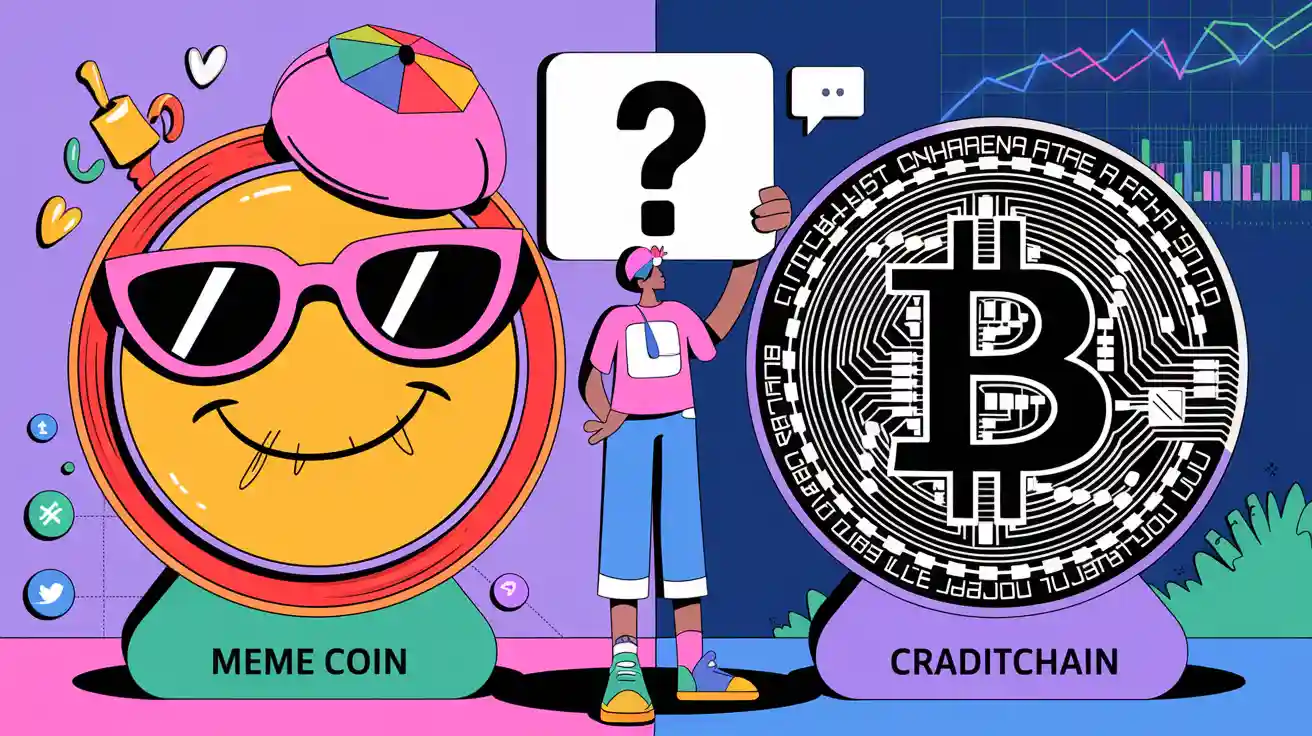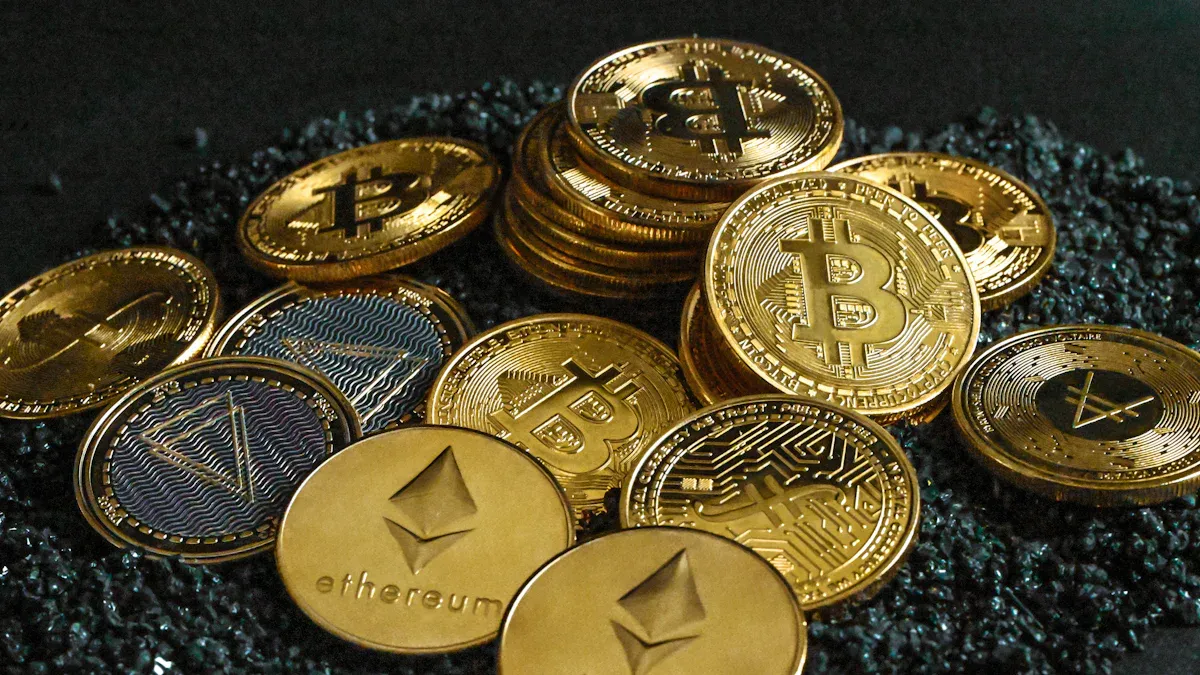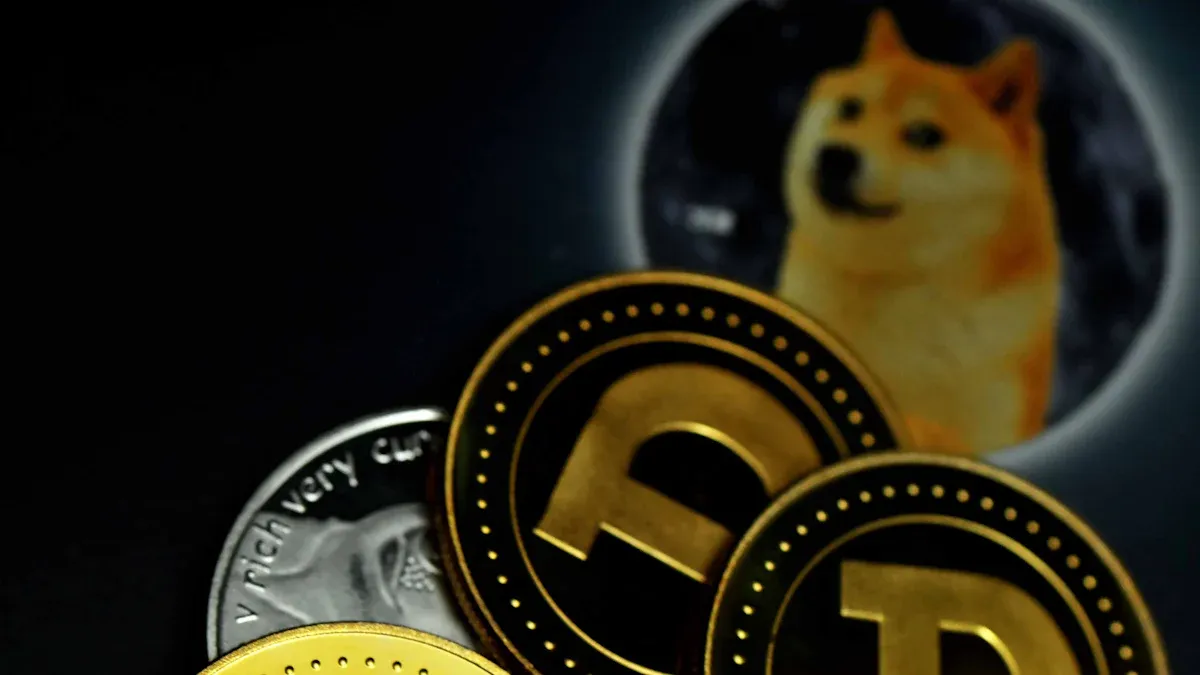Key Difference Between Meme Coin and Crypto for Beginners
2025-06-18 09:06:56
The main difference between meme coin and crypto is that meme coins are a playful, community-driven type of cryptocurrency, while cryptocurrencies include all digital coins and tokens, even those with serious uses and strong technology. Meme coins, like Dogecoin or Shiba Inu, often start as jokes or trends on the internet, and people trade them for fun or quick gains. Cryptocurrencies, such as Bitcoin, focus on security, technology, and real-world use. Knowing the difference between meme coins and other cryptocurrencies helps new investors avoid risky choices. Recent data shows meme coins appear and disappear quickly, with thousands launched daily and most lasting just over an hour, while established cryptocurrencies grow more slowly and have a longer life. This makes understanding the difference between meme coin and crypto important for anyone new to the crypto world.
Difference Between Meme Coin and Crypto

Definitions
Meme coins are a type of cryptocurrency that started as jokes or internet trends. They often use funny images, animals, or pop culture references. Meme coins like Dogecoin and Shiba Inu became popular because of social media and online communities. These coins do not always have a clear use or strong technology behind them. Instead, they rely on community support and viral attention.
Cryptocurrencies include all digital coins and tokens, such as Bitcoin, Ethereum, and altcoins. These coins use blockchain technology to create secure and transparent transactions. Most cryptocurrencies aim to solve real-world problems or offer new ways to transfer value. Altcoins are any cryptocurrencies other than Bitcoin. Some altcoins focus on privacy, speed, or smart contracts. The difference between meme coin and crypto becomes clear when looking at their origins and goals.
Meme coins reflect viral cultural trends and emotional appeal. They often appear in bull markets when people look for quick gains. Statistics show that 5,000 to 10,000 meme coins launch every day, but only a small number succeed. Over 80% of meme coin investors lose money, while only 1.4% earn more than $1,000. Meme coins are not measured by traditional utility but by how well they connect with younger generations and online communities.
Purpose
The purpose of meme coins and cryptocurrencies differs in important ways. Meme coins exist mainly for fun, entertainment, and community engagement. People buy meme coins to join a trend, support a joke, or try to make fast profits. These coins rarely offer real-world use or advanced technology. Their main goal is to create excitement and attract attention.
Cryptocurrencies, including altcoins, have more serious purposes. Bitcoin aims to be a digital store of value and a new form of money. Ethereum lets people build apps and smart contracts on its blockchain. Many altcoins try to improve on older cryptocurrencies by offering faster transactions, better privacy, or new features. The difference between meme coin and crypto shows up in these goals. Meme coins focus on hype and community, while cryptocurrencies focus on solving problems and building technology.
Investor surveys show that people buy meme coins for different reasons than other cryptocurrencies. Many want short-term returns, entertainment, or to follow social media trends. About 85% of U.S. crypto holders invest in meme coins, and 76% believe the rewards are worth the risks. In contrast, people buy cryptocurrencies for long-term growth, security, or to use new blockchain features.
Value Drivers
The value of meme coins and cryptocurrencies comes from different sources. Meme coins get their value from community interest, social media buzz, and viral stories. When a meme coin becomes popular online, its price can rise quickly. However, this value is often short-lived and can drop just as fast. Meme coins are also affected by bots and automated trading, which can create sudden price spikes or crashes.
Cryptocurrencies, including altcoins, get their value from technology, security, and real-world use. Bitcoin’s value comes from its limited supply and trust in its network. Ethereum’s value comes from its ability to run smart contracts and support many apps. Altcoins may offer new features or improvements over older coins. The difference between meme coin and crypto is clear in what drives their prices.
A recent study found that meme coin prices often follow Bitcoin’s price, but they react more to social media and community sentiment. Meme coins can act as inflation hedges, but they need strong community trust. Platforms like Pump.fun make it easy to create and trade meme coins, leading to rapid market growth. Over 600,000 new tokens appeared before April 2024, with 5,000 new tokens entering the market daily. Meme coins often have no pre-mines or inflation, making them seem fairer to some investors.
- Main value drivers for meme coins:
- Community engagement and hype
- Viral memes and cultural trends
- Social media activity and influencer support
- Easy access and low entry barriers
- Main value drivers for cryptocurrencies:
- Technology and security
- Real-world use and adoption
- Limited supply and trust in the network
- Ecosystem health and developer activity
Surveys show that retail investors drive speculative spikes in meme coins, while institutions stay cautious because of high volatility and scams. Meme coins are often manipulated by bots to boost excitement, which is less common in traditional cryptocurrencies.
The difference between meme coin and crypto matters for anyone entering cryptocurrency markets. Meme coins depend on community and trends, while cryptocurrencies rely on technology and real-world use. Understanding these value drivers helps new investors make safer choices in the fast-changing world of crypto.
Meme Coins vs Crypto
Community and Hype
Meme coins and cryptocurrencies attract different types of communities. Meme coins grow quickly because of social media. Platforms like Reddit, Twitter, and TikTok help these coins go viral. People share memes, join challenges, and use hashtags to spread the word. When a celebrity or influencer talks about a meme coin, many new buyers rush in. This creates a "halo effect" and can cause prices to jump. However, if the influencer leaves, the excitement can fade just as fast.
Landing pages for meme coins often show big follower counts and positive comments. These signs help new users feel like they are joining something popular. In contrast, cryptocurrencies focus more on long-term goals and partnerships. Their communities care about technology, security, and real-world use. Meme coins vs crypto shows how hype and community shape value in different ways.
Meme coins depend on fast-moving trends and group excitement. Cryptocurrencies build trust over time with steady growth and proven technology.
Utility and Technology
Meme coins and cryptocurrencies also differ in their technology and use. Meme coins often launch quickly. New tools let anyone create a memecoin in less than an hour. This makes it easy for people to join the market. Meme coins focus on fun, community, and viral marketing. They do not always have strong technology or clear use cases.
Cryptocurrencies like Bitcoin and Ethereum solve real problems. They use secure networks and offer features like payments, smart contracts, and decentralized finance. These projects take longer to build and need more testing. They also have higher market value and more users.
Some meme coins now add new features, such as decentralized exchanges, NFTs, and games. This shows that memecoins can grow beyond simple jokes. Still, most meme coins remain risky because they rely on hype, not technology. The memecoin market grew from $20 billion to $120 billion in 2024, showing how social trends can create value quickly.
- Key differences in utility and technology:
- Meme coins: Fast creation, focus on community, high risk, sometimes add new features
- Cryptocurrencies: Strong security, real-world use, slow growth, higher trust
Meme coins vs crypto highlights how social energy and technology shape the future of digital money.
Understanding the Meme Coins

Origins and Trends
Meme coins began as jokes on the internet, but they have grown into a major part of the crypto world. Dogecoin started this trend in 2013 by turning a popular dog meme into a digital currency. Over time, other memecoins like Shiba Inu and Pepe followed, each using humor and internet culture to attract attention. These coins do not rely on traditional business models or technology. Instead, they thrive on community support, shared jokes, and viral trends.
The table below shows how meme coins have changed over the years:
| Period | Key Events and Trends | Examples and Impact |
|---|---|---|
| 2013 | Dogecoin launched as the first meme coin, community-driven and humorous, using the Doge meme. | Created by Billy Markus and Jackson Palmer; early adoption via Reddit tipping culture; price ~$0.001. |
| 2018-2020 | Growing cult following; influencer posts sparked rallies. | $DOGE price remained below $0.01 but gained loyal community support. |
| 2021 | Meme mania during crypto bull run; rise of dog-themed coins like Shiba Inu. | $SHIB surged 1,000,000%; record trading volumes. |
| 2023-2024 | Solana blockchain fuels meme coin growth with low fees and high speed. | $WIF, $POPCAT, $BOME reached $1B+ market caps. |
| 2025 | AI-driven and Web3 meme coins emerge; market projected at $100 billion. | AI coins like $GOAT and Telegram tokens like $DOGS dominate. |
Memecoins reflect internet culture, humor, and the power of online communities. Platforms like Solana make it easy to launch new coins, helping trends spread quickly. Many people join for fun, hoping to catch the next viral hit.
Risks for Beginners
Understanding the meme coins means knowing the dangers. Meme coins show high volatility and can change in value very fast. Their prices often depend on social media trends, celebrity tweets, or group excitement, not on real-world use. This leads to the extreme volatility of meme coins, making them risky for new investors.
Common risks of buying meme coins include:
- Sudden price drops after a quick rise.
- Pump-and-dump schemes, where prices are pushed up and then crash.
- Lack of real value or use, making long-term growth unlikely.
- Scams and project abandonment.
- Low liquidity, which makes selling difficult.
Many memecoins are created for speculative trading. Beginners may lose money if they follow hype without research. The U.S. SEC treats meme coins like collectibles, not investments, because they lack strong fundamentals. Experts warn that the inherent risks are much higher than with established cryptocurrencies. To stay safe, beginners should research, avoid emotional decisions, and watch for pump-and-dump activity.
Tip: Always check a coin’s background and community before investing. Never risk more than you can afford to lose.
Difference Between Altcoins and Memecoins
Altcoins Overview
Altcoins make up all cryptocurrencies except Bitcoin. Developers create altcoins to improve blockchain technology or introduce new features. Many altcoins, such as Ethereum, Cardano, and Solana, offer real-world uses. For example, Ethereum supports smart contracts and decentralized apps. Cardano focuses on security and sustainability. Solana provides fast and low-cost transactions.
Altcoins often use advanced technology to solve problems in the crypto world. They may use new security methods or help different blockchains work together. The Analytics Insight Cryptocurrency Market Report for May 2025 shows that altcoins like Ethereum and Solana have strong technical bases. These coins show bullish trends and attract both retail and institutional investors. The 21Shares report highlights that altcoins now focus more on real utility and innovation, such as AI integration and zk-rollups. Many altcoins also benefit from clear regulations and strong partnerships, which help them grow.
A recent Grand View Research report found that the Asia Pacific region leads in altcoin innovation. Companies like Binance and Ripple drive growth through new technology and strategic moves. The report predicts a 13.1% annual growth rate for the altcoin market from 2025 to 2030.
Memecoins Overview
Memecoins started as internet jokes but now play a big role in the crypto market. Most memecoins use existing technology, like Ethereum’s ERC-20 standard. They do not focus on solving real-world problems. Instead, they attract users with humor, viral trends, and strong online communities.
The difference between altcoins and memecoins stands out in their purpose and technology. Altcoins aim for innovation and practical use. Memecoins rely on hype and community excitement. The table below highlights these differences:
| Aspect | Altcoins | Meme Coins |
|---|---|---|
| Purpose | Created with specific objectives to improve blockchain technology or introduce new applications. | Often created randomly, designed to attract specific groups, initially speculative. |
| Technology | Leverage innovative and advanced technologies to solve blockchain issues. | Mostly ERC-20 tokens built on existing tech like Ethereum or Bitcoin. |
| Use Cases | Have practical, real-world applications (e.g., Ethereum for dApps, Polkadot for interoperability). | Mainly for entertainment, speculative trading, or social media tipping. |
| Price Volatility | Less volatile due to solid project foundations supporting investment decisions. | Highly volatile, driven by hype and speculation rather than intrinsic value. |
| Community | Diverse communities with varied interests in the project. | Strong, dedicated communities critical for survival and growth (e.g., Dogecoin, Shiba Inu). |
Trading data shows that memecoins like SHIBA INU have extreme price swings and poor liquidity. These coins often lack clear utility, which leads to high risk for investors. In contrast, altcoins with strong tokenomics and active development attract more stable investment and higher trading volumes. The difference between altcoins and memecoins helps investors understand why meme coins vs altcoins often means choosing between innovation and speculation.
Examples
Meme Coins
Dogecoin and Shiba Inu stand out as two of the most famous meme coins. Dogecoin started in 2013 as a joke based on a popular dog meme. It quickly gained a large following because of its fun culture and strong presence on social media. The coin reached a $1 billion market cap by early 2018. Celebrity tweets, especially from Elon Musk, helped boost its popularity. Shiba Inu launched in 2020 as a Dogecoin-inspired token. Its community, known as the Shib Army, grew fast. Shiba Inu expanded its ecosystem with projects like ShibaSwap and the Shibarium blockchain. Both coins have shown that community support and viral trends can drive value, even when prices swing wildly.
| Meme Coin | Launch Year | Key Features / Community Impact | Market Events and Performance |
|---|---|---|---|
| Dogecoin (DOGE) | 2013 | First meme coin, large active community, Proof-of-Work system | Hit $1B market cap in 2018, surged past $57B by Nov 2024 |
| Shiba Inu (SHIB) | 2020 | Strong Shib Army, ecosystem projects like ShibaSwap, Shibarium | Rapid rise after Binance listing, high volatility, ecosystem crash |
| Pepe Coin (PEPE) | 2023 | Viral meme culture, exploring new uses | Quick popularity from social media hype |
| OFFICIAL TRUMP | 2025 | Linked to Trump NFTs, political and celebrity associations | Gained attention at launch |
Meme coins often have short lifespans and high risk. Their value depends on social media, celebrity influence, and community excitement.
Other Cryptocurrencies
Mainstream cryptocurrencies like Bitcoin and Ethereum show a different path. Bitcoin started in 2009 as the first digital currency. It uses a secure network and has a clear purpose as a store of value. Ethereum launched in 2015 and introduced smart contracts, allowing people to build apps on its blockchain. These cryptocurrencies have strong technology, clear use cases, and stable market positions. Altcoins such as Cardano and Solana also focus on solving real problems. Cardano aims for security and sustainability, while Solana offers fast and low-cost transactions.
| Category | Examples | Key Characteristics | Market Behavior and Performance |
|---|---|---|---|
| Mainstream Cryptocurrencies | Bitcoin, Ethereum | Strong technology, defined use cases, stable markets | High market cap, long-term growth, real-world adoption |
| Altcoins | Cardano, Solana, Polkadot | Innovation, practical uses, advanced features | Attract stable investment, focus on utility and growth |
These examples show the main difference between meme coins and traditional cryptocurrencies. Meme coins rely on hype and community trends, while altcoins and other cryptocurrencies focus on technology, security, and real-world use. Investors see more stability and long-term potential in altcoins, while meme coins offer quick excitement but higher risk.
Meme coins and traditional cryptocurrencies differ in purpose, technology, and risk. Meme coins often show extreme price swings and lack strong fundamentals, making them targets for pump-and-dump schemes. In contrast, established cryptocurrencies offer unique technology and real-world solutions, ranking higher in market value. Beginners should treat meme coins as entertainment, invest small amounts, and view them as a potential investment with high risk. Careful research and attention to market trends help protect against losses.
FAQ
What makes meme coins different from regular cryptocurrencies?
Meme coins often start as jokes or trends. Regular cryptocurrencies, like Bitcoin, focus on technology and real-world use. Meme coins rely on community excitement. Regular cryptocurrencies use strong security and have clear goals.
Are meme coins safe for beginners to invest in?
Meme coins carry high risk. Their prices can change quickly. Many lack real value or use. Beginners should research before buying. Experts suggest only investing money that one can afford to lose.
Can meme coins become valuable over time?
Some meme coins gain value if they become popular. Most lose value quickly. Only a few, like Dogecoin, have lasted. Popularity and community support drive their price, not technology or real-world use.
How can someone spot a risky meme coin?
A risky meme coin often has no clear purpose, anonymous creators, or little information. Sudden price jumps and heavy social media hype can signal danger. Beginners should check the project’s website and community before investing.